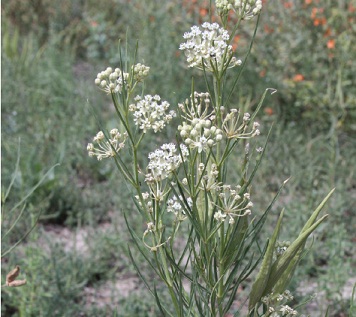|

Horsetail milkweed (Asclepias subverticillata) is one of the more toxic species of milkweed plants
Chemical structure of oleandrin, one of the cardiac glycosides
Asclepias L. (1753), the milkweeds, is a genus of herbaceous perennial, dicotyledonous plants that contains over 140 known species. It previously belonged to the family Asclepiadaceae, but this is now classified as the subfamily Asclepiadoideae of the dogbane family Apocynaceae.
Milkweed is named for its milky juice, which contains alkaloids, latex, and several other complex compounds including cardenolides. Some species are known to be toxic. Carl Linnaeus named the genus after Asclepius, the Greek god of healing, because of the many folk-medicinal uses for the milkweed plants.
Pollination in this genus is accomplished in an unusual manner. Pollen is grouped into complex structures called pollinia (or "pollen sacs"), rather than being individual grains or tetrads, as is typical for most plants. The feet or mouthparts of flower visiting insects such as bees, wasps and butterflies, slip into one of the five slits in each flower formed by adjacent anthers. The bases of the pollinia then mechanically attach to the insect, pulling a pair of pollen sacs free when the pollinator flies off. Pollination is effected by the reverse procedure in which one of the pollinia becomes trapped within the anther slit.
Asclepias species produce their seeds in follicles. The seeds, which are arranged in overlapping rows, have white silky filament-like hairs known as pappus, silk, or floss. The follicles ripen and split open and the seeds, each carried by several dried pappus, are blown by the wind. They have many different flower colorations.
Ecology
Milkweeds are an important nectar source for bees and other nectar-seeking insects, and a larval food source for monarch butterflies and their relatives, as well as a variety of other herbivorous insects (including numerous beetles, moths, and true bugs) specialized to feed on the plants despite their chemical defenses. Milkweeds use three primary defenses to limit damage caused by caterpillars: hairs on the leaves, cardenolide toxins, and latex fluids. Data from a DNA study indicate more recently evolved milkweed species use less of these preventative strategies, but grow faster than older species, potentially regrowing faster than caterpillars can consume them.
Uses
The milkweed filaments from the follicles are hollow and coated with wax, and have good insulation qualities. During World War II, over 5,000 t (5,500 short tons) of milkweed floss was collected in the United States as a substitute for kapok. As of 2007, milkweed is grown commercially as a hypoallergenic filling for pillows. A study of the insulative properties of various materials found that milkweed was outperformed by other materials in insulation, loft, and lumpiness, but scored well on various metrics when mixed with down feathers.
Seeds
In the past, the high dextrose content of the nectar led to milkweed's use as a source of sweetener for Native Americans and voyageurs. The bast fibers of some species can be used for cordage. Milkweed latex contains about 1 to 2% latex, and was attempted as a source of natural rubber by both Germany and the United States during World War II. No record has been found of large-scale success. Milkweed is beneficial to nearby plants, repelling some pests, especially wireworms.
Milkweed also contains cardiac glycoside poisons which inhibit animal cells from maintaining a proper K+, Ca+ concentration gradient. As a result many natives of South America and Africa used arrows poisoned with these glycosides to fight and hunt more effectively. Milkweed is toxic and may cause death when animals consume 10% of their body weight in any part of the plant. Milkweed also causes mild dermatitis in some who come in contact with it.
Being the sole food source of monarch butterfly larvae, the plant is often used in butterfly gardening. In a garden, milkweed flowers will produce a strong and beautiful fragrance that will be as powerful as in any other flower.
Conclusion: "Although milkweed is unpalatable to horses, the potential for death due to ingestion of the plant is high. Therefore, horse owners should take appropriate measures to rid their pastures of milkweed and ensure that the hay they provide their horses is safe and free of milkweed. As is the case with many plant poisonings, preventing consumption of the plant is the only guaranteed means of avoiding toxicity and potential death."
For More Information:
Milkweed Poisoning of Horses 
|